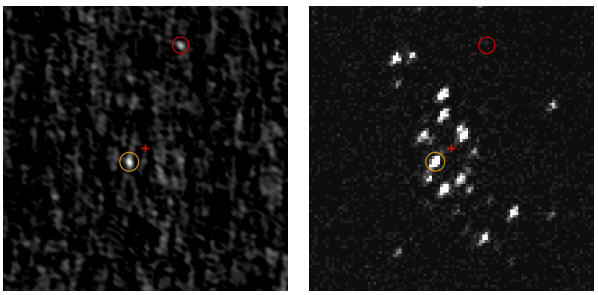Two black holes in a collection of stars known as a globular cluster are not unique - another black hole candidate has been found in globular cluster M62.
The globular cluster M62 is located in the constellation Ophiuchus, about 22,000 light years from Earth. Black holes are stars that have died, collapsed into themselves and now have such a strong gravitational field that not even light can escape from them.
Until recently, astronomers had assumed that the black holes did not occur in globular clusters, which are some of the oldest and densest collections of stars in the universe. Stars are packed together a million times more closely than in the neighborhood of our sun.
There are so many stars in such a condensed area that they often interact with one another. Massive black holes would have the most violent encounters, "sling-shotting" each other out of the cluster.

VLA 6.2 GHz radio (left) and Chandra X-ray (right) images of the central 50′′ (1.6 pc) of M62, showing the candidate BH M62-VLA1 (orange circle). A red cross marks the cluster photometric center (L¨utzgendorf et al. 2013). The other radio source in the central region of M62 is a known pulsar (red circle; Possenti et al. 2003). North is up and east is to the left. Credit: arXiv:1306.6624
"This implies that the discovery of the other black hole, in the globular cluster called M22, was not just a fluke," said Laura Chomiuk, team member and MSU assistant professor of physics and astronomy. "Black holes really may be common in globular clusters."
Last year's discovery of a pair of black holes in a cluster was especially surprising, Chomiuk said. It had been thought that if two black holes dwelled at the center, they would regularly encounter one another until one shoved the other out. "I think it's safe to say that we have discovered a whole new hunting ground for black holes."
This latest discovery was made by using the National Science Foundation's Karl G. Jansky Very Large Array telescope in New Mexico.
Preprint: Laura Chomiuk (Michigan State/NRAO), Jay Strader (Michigan State), Thomas J. Maccarone (Texas Tech), James C. A. Miller-Jones (ICRAR-Curtin), Craig Heinke (Alberta), Eva Noyola (UNAM), Anil C. Seth (Utah), Scott Ransom (NRAO), 'A Radio-Selected Black Hole X-ray Binary Candidate in the Milky Way Globular Cluster M62', arXiv:1306.6624
Upcoming in Astrophysical Journal






Comments